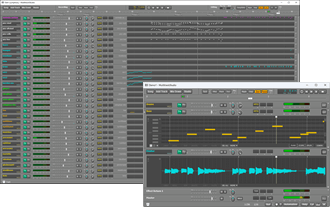

All you need to bring is some sounds, your talent, and most of all, your creativity. What is a Digital Audio Workstation (DAW)?Ī digital audio workstation is essentially a blank piece of paper and the necessary paint brushes for an artist to create their works of art on. Let’s review the top 10 best digital audio workstations out today and help you pick which DAW is best for you. With that being said, picking the best DAW can be dependent on a few factors. You also need to optimize your workflow to simplify the process of making music so you don’t even have to think anymore - you can just create.
STUDIO RECORDING FOR MAC WITH MIDI SUPPORT FULL
In our opinion you need the proper software to give you the full capabilities of the song you’ve worked so hard on building inside of your head - something to really transfer those ideas into a reality. Perhaps you’re looking to switch to a more popular, supported digital audio workstation? Some say its all about the musician and that the recording software doesn’t matter…we agree, but to a certain extent. To indicate a MIDI thru connection, connect the two MIDI devices to the same port of the MIDI interface device.So you’ve got the gear, but do you have the software to lay it all down with? You can’t paint without a canvas. You can’t specify a “MIDI thru” connection between two MIDI devices. If it doesn’t, see If a connected MIDI device isn’t shown. If you have a MIDI interface connected to the USB port on your Mac, it should appear in the MIDI Studio window. In List View, click a device’s disclosure triangle, click the Port disclosure triangle, click the Add Connection icon, then use the pop-up menus to specify the connections. In Icon View, drag the In or Out connectors at the top of a device icon to the corresponding connector on another device icon. In the MIDI Studio window, specify the connection between MIDI devices: Repeat steps 4 through 7 for each MIDI device you want to include in the configuration. To turn a profile on or off, select or deselect its checkbox. Select MIDI-CI profiles for interface devices: If an interface device supports MIDI-CI, click MIDI-CI to see the profiles available on each channel. To delete a port, select it in the list, then click the Remove button. Also select whether to use the MIDI Beat Clock, the MIDI Time Code, or both, then select other features.Īdd or remove ports: Click Ports, click the Add button below the list of ports, then specify the MIDI In and MIDI Out connectors for the port. Set the device channels and other properties: Click Properties, then click the channels to use for transmitting and receiving audio. If you know the manufacturer and model, you can enter those.Ĭhange the device icon: Click the MIDI device’s icon to open the Icon Browser, select a different icon to represent the device, then click the new icon to close the Icon Browser.Ĭhange the device color: Click the color well, select a different color to use for the MIDI device, then close the Colors window. In the Properties window, do any of the following:ĭescribe the device: Enter a name for the MIDI device the name appears in apps you use with the device. To set properties and add or remove ports for the MIDI device, double-click the device, or select it, then click the Device Info button in the toolbar. To add a new external MIDI device, click the Add button in the MIDI Studio toolbar. In the MIDI Studio window, click the Choose MIDI Configuration pop-up menu (it may show Default), then choose New Configuration.Įnter a name for the new configuration, then click OK.

To view its ports, or to connect or disconnect devices, click the device’s disclosure triangle. To view information about a device, double-click the device. To filter which devices are shown, click the Show pop-up menu, then choose an option (such as Online or Connected).


If a device isn’t connected, it’s dimmed. Show List View : Devices in the configuration are shown in a list, organized by type (such as Interface or External Device). To view information about a device, such as channel properties and ports, and to add or remove ports, double-click the device’s icon. If a device isn’t connected, its icon is dimmed. Show Icon View : Devices in the configuration are shown as icons. In the toolbar, click the following buttons to change how the configuration is shown: In the MIDI Studio window, click the Choose MIDI Configuration pop-up menu (it may show Default), then choose the configuration you want to view. In the Audio MIDI Setup app on your Mac, choose Window > Show MIDI Studio.


 0 kommentar(er)
0 kommentar(er)
